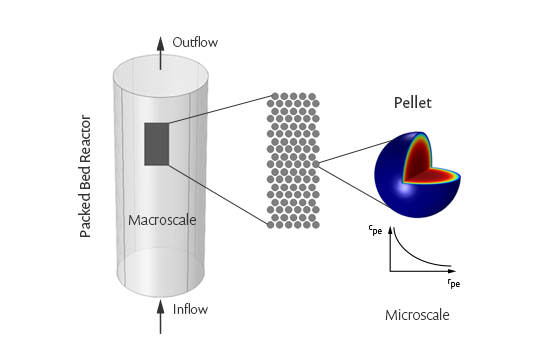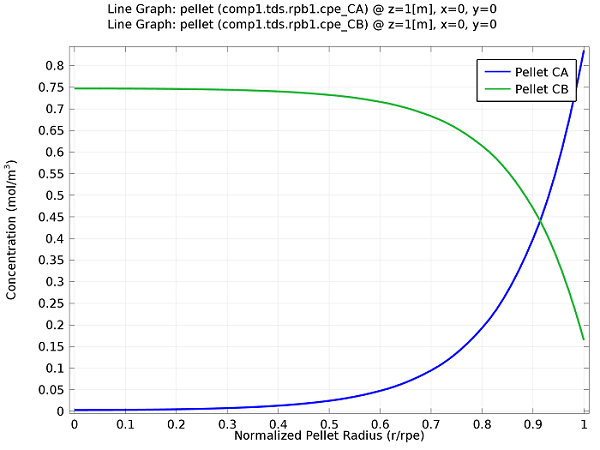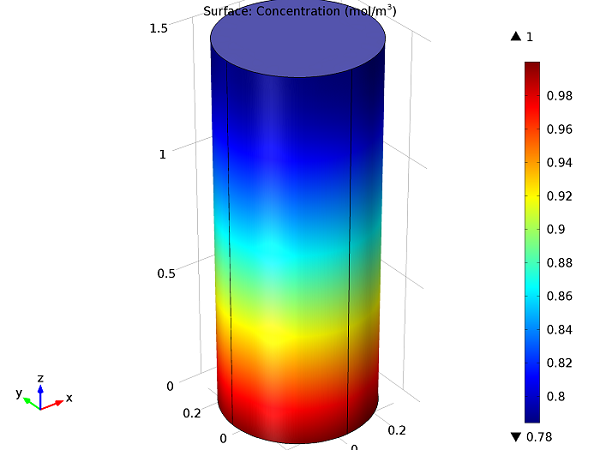
Probably the most common reactor in the chemical industry is the packed bed reactor. This reactor is used in chemical synthesis and for effluent treatment and catalytic combustion. Oftentimes, heterogeneous catalysis requires packed beds. A common design is a cylindrical column filled with catalyst pellets. The pellets can be contained within supporting structures, like tubes or channels, or packed in a single compartment in the column. The latter is called dumped packing.
Porous Media
The key, here, is that the pellets or beads are porous. In other words, they have very small channels inside. The reactant gas or liquid mixture is pumped from the bottom of the column and as it passes around the dumped pellets, some reactant diffuses into the pores; reacts; and then leaves the pellet again as the product. This product mixture is then passed on to the top of the column and drawn off, usually to be purified in subsequent process steps.
The Challenge
When creating a computational model of a packed bed reactor that takes into account the geometrical shape, you are faced with a major challenge: A realistic reactor can contain hundreds of thousands of pellets of various sizes, and each pellet contains countless microscale pores. Resolving all these details with a finite element mesh would require prohibitively many computation points (degrees of freedom). In practice, it is impossible to handle such a detailed model.
The Solution: Fourth Dimension Added in Version 5.0
With COMSOL Multiphysics version 5.0, we introduce the Reactive Pellet Bed feature. It “attaches” an extra dimension to the existing 3D spatial dimensions, which models the reacting flow inside each porous catalytic pellet. In other words, we’re coupling the 3D description of fluid dynamics and material transport, along with any reactions in the macroscale, to the 1D description of material transport and chemical reaction in the pellets. The feature also allows the user to account for a distribution in pellet size.

The extra dimension in the reactive pellet bed simulates the microscale — what is happening inside of each dumped pellet — throughout the 3D column. The fluid between the pellets is simulated in the ordinary three space dimensions, i.e., the macroscale. The color in the 3D pellet plot reflects the distribution in chemical species concentration.
The Multiscale 3D Packed Bed Reactor model demonstrates a simple irreversible chemical reaction A \rightarrow B that takes place in the pellets. The concentration distribution of the reactant and product can be plotted at any position in the column, as well as the macroscale concentration in the fluid passing through the bed and out of the reactor.

The concentration of reactant A (blue) and product B (green) in a pellet in the middle of the reactor at a position 1 meter above the inlet. This type of plot can be produced for a pellet at any position in the reactor. The concentrations change most quickly near the surface of the particle, r/rpe = 1.

A plot of the reactant concentration, CA, in the macroscale.
Summary and Next Steps
Modeling in this way makes it possible to solve multiscale problems without having to create the geometry and mesh the individual pellets, which would be virtually impossible. Using attached dimensions has great potential to solve other types of problems, such as heat transfer across very thin shells. We will dive into that subject in an upcoming blog post, so stay tuned.
- Download the model: A Multiscale 3D Packed Bed Reactor
- See what’s new in COMSOL Multiphysics version 5.0




Comments (0)